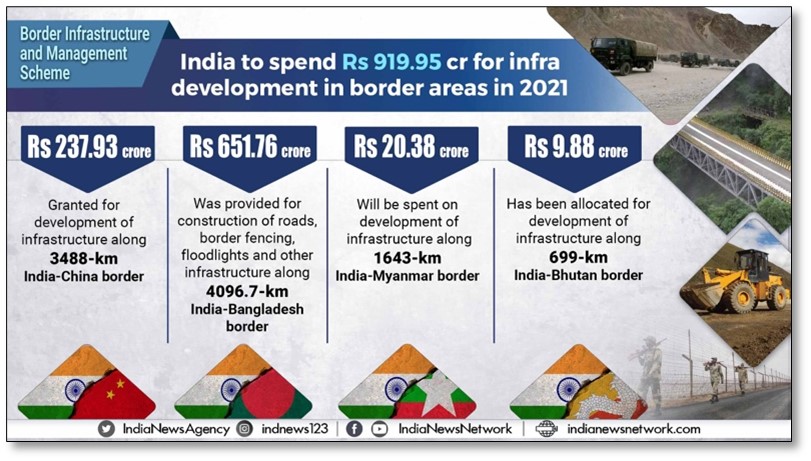Thursday, 3rd March 2022
Gender Roles Report
In News
A report has been released by Pew Research Center ahead of International Women’s Day based on a survey conducted in India in 2019-20.

Survey findings
- Indians broadly accept women as political leaders.
- Most adults say that women and men make equally good political leaders (55%) or that women generally make better leaders than men (14%).
- While most Indians say that men and women should share some family responsibilities, many still support traditional gender roles.
- 62% of adults say both men and women should be responsible for taking care of children, while roughly a third of adults feel that child care should be handled primarily by women.
- Similarly, only a slim majority (54%) say that both men and women in families should be responsible for earning money.
- Nearly nine-in-ten Indians (87%) completely or mostly agree with the notion that “a wife must always obey her husband.”
- An overwhelming majority of Indian adults say it is very important for families to have both sons and daughters, and a substantial share are accepting of sex-selective abortion.
- Indians are united in the view that it is very important for a family to have at least one son (94%) and, separately, a daughter (90%).
- Indians favour teaching boys to respect women as a way to improve women’s safety.
- Three-quarters of Indian adults (76%) say violence against women is a “very big problem” in their country.
- About half of Indians (51%) say it is more important to teach boys to respect all women, while roughly a quarter (26%) say it is more important to teach girls to behave appropriately.
- Compared with people in other countries around the world, Indians have relatively traditional views on gender roles.
- Despite broadly aligning with global public opinion on equal rights for women, Indians tend to be more conservative than people in most other countries surveyed when it comes to gender dynamics in the home and in the economy.
- Only one out of 61 countries surveyed has a higher share of adults than in India who agree completely with the notion that men should have greater rights to a job than women when jobs are scarce.
Differences across the demographic:
- Across States: Even though faring better in education and life expectancy, southern states not necessarily more egalitarian than Hindi Belt states in gender attitudes.
- For example, While Indians in the South are less likely than those in the Hindi Belt to say that a wife must always obey her husband (75% vs. 94%), Southern adults are more likely to say that men in families should be responsible for making decisions about expenses (25% vs. 13%) and that women should be primarily responsible for taking care of children (44% vs. 30%).
- Across Educational Qualifications: Indian adults with a college degree are less likely than those without a college education to support conservative gender norms.
- For example, about a quarter of college-educated Indians (24%) say women in a family should be primarily responsible for taking care of children, while roughly a third of Indians with less formal education (35%) say child care responsibility should rest with women.
- Across Religion: India’s main religious groups have widely divergent opinions about gender roles in the family.
- For example, while nearly three-quarters of Indian Muslims (74%) say that sons should have the primary responsibility for a parent’s burial rituals, just 29% of Sikhs say that sons alone should handle last rites. In general, Muslims are the most likely, and Sikhs are the least likely, to support traditional gender roles.
- Across Gender: Across a variety of measures, Indian men are more likely than women – but only slightly – to take a traditional view of gender roles.
- For instance, 82% of men say that when there are few jobs, men should have more rights to jobs, compared with 77% of women who share this perspective.
Sources:
Russian threat to ISS
In News
Russian space agency has threatened with a possibility letting the ISS fall from space
About the News
- Amid Russian invasion of Ukraine and followed USA sanctions, Russia has recently threatened USA with the possibility of dropping the 420-tonne ISS spacecraft which is a permanent laboratory in space where the United States, Russia and some other countries work as partners.
- The threat emanated from the fact that Russia provides the propulsion system of the ISS which keeps it in the pre-defined orbit.
- Its orbital flight path could drop over US or Europe, or over India and China as it does not take it over most of the Russian territory.
- Although the threat has been played down by NASA as historically ISS has remained immune from geopolitical tensions but the present conflict has the potential to affect space cooperation in other ways.
What is International Space Station?
- Background: The ISS has been manned continuously since the start of operations in 1998. At any given time, there is a crew of six astronauts on board. The ISS has been in operation since 1998 and is expected to continue at least till 2028
- Laboratory: The facility is used for carrying out a variety of zero-gravity experiments, space exploratory studies, and technology development.
- Altitude: The ISS or International Space Station is the only operational space laboratory as of now, orbiting the earth in a trajectory that is about 400 km above the land surface.
- Partner countries: It is operated by more than 15 partner countries. Apart from Russia and the United States, Canada, Japan and several members of the European Space Agency are partners in the ISS.
- Manoeuvre: ISS travels at a speed of about 28,000 km per hour. It completes one journey around the earth in about one and a half hours. In one day, therefore, it makes about 16 trips around the world.
- S. segment: US manages power and the systems that make the spacecraft habitable.
- Russian segment: It is “Zvezda module” of ISS which provides the propulsion system of the ISS which keeps it in the pre-defined orbit.
- Other labs: The ISS is not the first space station to be built and operated. Several smaller space stations have been used earlier including Russian Mir space station that operated in the 1980s, and the American Skylab.
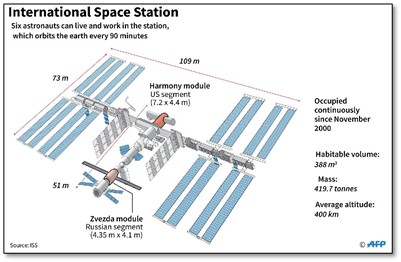
What are the major issues?
- Fallout: ISS is not entirely in zero-gravity space. It does encounter a little bit of gravity. It loses a bit of energy as it moves around the earth. Left to itself, the ISS would fall down.
- Leverage of Russia: The Russians periodically send thrusters that attach themselves to the ISS and impart the required momentum to keep it going. If removed, the US and other countries would not be able to keep the ISS from falling down if Russia withdrew its support.
- Loss for future space cooperation: The ISS is the most visible part of a wide-ranging space collaboration between US and Russia. Possible fallout will push planned mission to Venus i.e., “Venera-D mission” many years back.
Sources:
Indian MBBS overseas graduates
In News
The recent war in Ukraine has highlighted the plight of Indian medical students studying abroad.
About the News
- Recent records have shown a three-fold increase in the number of candidates taking the Foreign Medical Graduates Examination (FMGE) over the last five years.
- This increase is despite India adding nearly 30,000 new medical seats during the same period.

What are the possible reasons?
- Increasing Demand for Medical care: Rising population and increasing demand for medical care under the dual burden of disease both communicable and non-communicable added to the slow medical expansion in India due to lack of advanced planning and policy paralysis is one of the most important reasons.
- Student to seat ratio: Over 16 lakh students had appeared for NEET-UG in 2021 for just over 83,000 MBBS seats available across the country, only half in government colleges.
- Low doctor to patient ratio: As per the suggested doctor patient ratio of 1:1000 by the World Health Organisation, India needs 1.38 million doctors.
- Lower cost of Education: Many students who do not get a set in government medical colleges in India prefer to study in these Asian and east European countries because of the lower cost of education as compared to private colleges in India.
- Quality of Education and Work Opportunities: The number of top colleges providing quality education in the country is limited and domestic applicants face a lot of competition, whereas foreign nations with relatively smaller populations and a variety of education options allow these students to pursue their dream education overseas.
- Very High cost of Medical Education: A policy for capping the fees for atleast 50% seats in private medical colleges that would charge fees equal to what the government colleges do will be a welcome step.
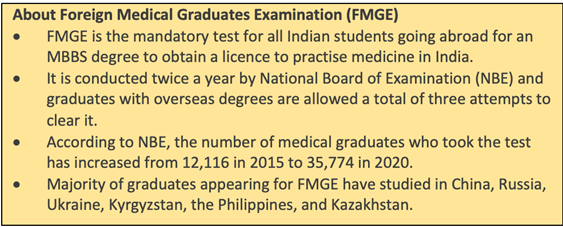
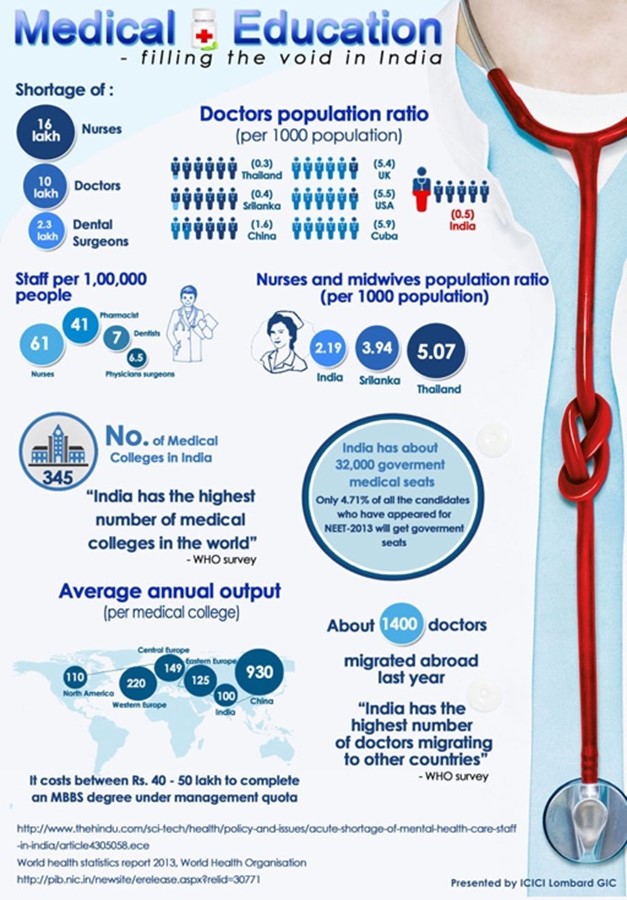
Source:
- In 5 years, a 3-fold hike in number of Indian MBBS overseas graduates seeking to practise at home
- 4 key factors why India is seeing rise in studying abroad
- Why Indian Medical Students Are Forced To Study Abroad And How Good Policies Can Change The Situation
Picture source:
Jamsetji Nusserwanji Tata
On March 3, 1839, Father of Indian Industry Jamsetji Nusserwanji Tata was born in a Zoroastrian-Parsee family, to Nusserwanji and Jeevanbai Tata in Navsari, Gujarat. He established the city of Jamshedpur and founded the Tata group. He also made contributions for establishment of IISc, Bengaluru. Pandit Jawarharlal Nehru had once described him as a ‘one-man planning commission’, considering him as the brain behind India’s industrial growth story. He is considered as the man who placed India on the industrial map of the globe. In 1869, he bought and converted a bankrupt oil mill into a cotton mill, later selling it at a profit after two years. Then, he floated the Central India Spinning, Weaving, and Manufacturing Company in Nagpur. In 1877, he established another cotton mill, ‘Empress Mill’, named after Queen Victoria, the Empress of India in 1877.
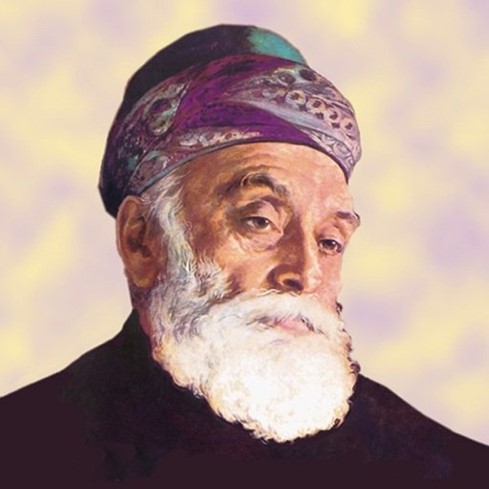
Source:
Marital Rape and Conjugal Rights
In News
The Union government has urged the Delhi high court to defer hearing a bunch of petitions that seek to criminalize marital rape.
About the News
- The petitions have sought to strike down the exception in the Indian rape laws on the grounds that it discriminated against married women who were sexually assaulted by their husbands.
- Exception 2 of Section 375 of the Indian Penal Code (IPC) decriminalises marital rape and mandates that sexual intercourse by a man with his own wife, even if it is without her consent, is not rape. In October 2017, the Supreme Court increased the age of consent to 18 years.
- The Union government has said that while it is neither “yes” or “no” from their side on the issue now and it is not withdrawing its earlier stand filed in 2017 that it opposes the petitions seeking to criminalise marital rape.
- In August 2017 the Centre said India cannot blindly follow the West and criminalise marital rape as several factors must be considered.
What is Marital Rape?
- Marital rape is sex by spouse with his better half without her assent or by compel or danger. Marital rape is not an offense in India. Enactments regarding marital rape in India are either non-existent or esoteric and dependant on the understanding by Courts.
- Section 375, the provision of rape in the Indian Penal Code (IPC), mentions as its exception clause- “Sexual intercourse by man with his own wife, the wife not being under 15 years of age, is not rape.” Section 376-A criminalizes the rape of judicially separated wife.
- Also, both the spouses have the right for 'Restitution of Conjugal Rights' under Divorce Act, 1869 (related to the divorce of persons belonging to the Christian religion), Special Marriage Act (SMA) of 1954 and Hindu Marriage Act (HMA) of 1955 etc.
- According to the Indian government's latest National Family Health Survey, about 30% Indian women aged 18-49 reported having experienced spousal violence. In terms of sexual violence, the average Indian woman is 17 times more likely to face sexual violence from her husband than from anyone else, according to the survey of 724,115 women.
Why is the provision of exception of Marital Rape in place?
Marital rape immunity is known to several post-colonial common law countries. The exemption for marital rape stems from a long-outdated notion of marriage, which regarded wives as no more than the property of their husbands. It is premised on broadly two assumptions:
- Consent in Perpetuity: This is the assumption that on marriage a woman gives consent held by her husband in perpetuity which she cannot retract. This concept in the colonial-era law has roots in the antiquated idea that a woman is the property of her man.
- Expectation of Sex: This is the assumption that a woman is duty-bound or is obligated to fulfil sexual responsibilities in a marriage since the aim of marriage is procreation. Since the husband has a reasonable expectation of sex in a marriage, the provision implies that a woman cannot deny it.
Need for Criminalizing Marital rape
- Marital rape immunity stands against the light of the right to equality, the right to life with dignity, personhood, sexual, and personal autonomy — all fundamental rights protected under Articles 14, 19 and 21 of the Constitution India being the largest democracy of the world cannot remain silent on the issue.
- Misuse of criminalization is not valid as there is no law in our country which is not being misused. If it is of no use, then it cannot be misused too and if use paramount then it will outweigh the misuse.
- Victims of marital rape undergoes same trauma as in case of rape by stranger. They bear more psychological pain as they are unable to complain to anybody. In case of rape by stranger the victim gets both support and sympathy from the society which is not always the case in marital rape.
- The exemption under the IPC is unconstitutional as it undermines consent of a woman based on her marital status.
- The question arises whether the protection of marriage and family can be a compelling or even legitimate interest for the state to the extent that it can make laws that violate fundamental rights.
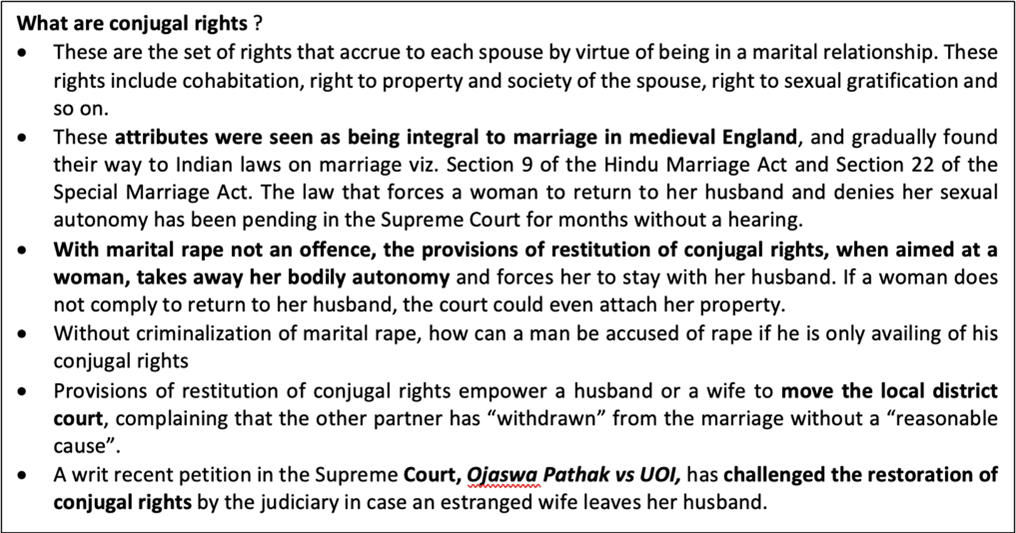
What are the challenges that criminalizing of Marital rape create?
- In marital rape the degree of evidence required to prove non-consent and whether the resistance is essential element to prove the charge, is a complex problem for criminalization of marital rape.
- Criminalizing marital rape involves a socio-legal impact and intimate family relations, which requires a comprehensive approach rather than a strictly legal view to conclude.
- Preservation of the family institution by ruling out the possibility of false, fabricated, motivated complaints of ‘rape’ by ‘wife’ against her ‘husband’ and the pragmatic procedural difficulties that might arise in such a legal proceeding”.
- Marital rape is a sensitive topic, difficult to measure anywhere, but even more so in India – where most sexual violence is believed to occur within families and goes unreported.
- The criminalization of marital rape might raise questions on the laws regarding restitution of Conjugal rights.
- It may lead to rise in false cases and serve as an increased burden to the already overburdened legal system. Also, there has been rising misuse of Section 498A (harassment caused to a married woman by her husband and in-laws) of IPC.
- Rates of reporting and conviction also remain low, aggravated by the prevalent beliefs that marital rape is acceptable or is less serious than other types of rape.
Way Forward
- Justice Verma Committee has recommended that relationship between the accused and the complainant is not relevant to the enquiry into whether the complainant consented to the sexual activity and the fact that the accused and the victim are married or in another intimate relationship may not be regarded as a mitigating factor justifying lower sentences for rape.”
- “ubi jus ibi remedium” – where there is a right there is a remedy. Without remedy, right has no value. Therefore, if we recognize such conjugal right there must be some remedy. Such remedy is dissolution of marriage under the law.
- It is also important that the legal prohibition on marital rape is accompanied by changes in the attitudes of prosecutors, police officers and those in society more generally.
- Changes in the law, therefore, need to be accompanied by widespread measures raining awareness of women’s rights to autonomy and physical integrity, regardless of marriage or other intimate relationship.
Question: Criminalization of marital rape is highly contentious issue. Discuss.
Sources:
- Centre urges Delhi high court to halt hearings on marital rape:
- Marital Rape versus Conjugal Right:
- Explained: The debate over marital rape:
- Restitution of Conjugal Rights:
- Explained: Conjugal rights before the Supreme Court:
- Marriage is not a valid defence against rape, says committee:
- Marital Rape And Rights Of Women:
- How Conjugal Rights are in contradiction with Marital rape?:
- Delhi HC on Marital Rape: ‘Irrespective of Marital Status, Every Woman Has the Right to Say No':
- All you need to know about marital rape:
- Does a wife's conjugal duty protect marital rape?:
- Husband’s conjugal expectations can’t override wife’s right to say no, Amicus Curiae tells Delhi HC in the challenge to the marital rape exception case:
- Plea on conjugal rights pending in Supreme Court:
Dippy the dinosaur
This is image of London's 26-metre-long Dippy is a plaster cast replica of the fossilised bones of a diplodocus carnegii skeleton. The fossilised skeleton from which Dippy was cast was discovered in Wyoming in 1899. It was acquired by the Scottish-American industrialist Andrew Carnegie for the still under construction Carnegie Museum of Natural History in Pittsburgh, where it still stand. Reportedly 292 cast pieces of the skeleton were sent to London in 36 crates and the model was assembled under the supervision of Carnegie scientists. Considered the most famous single dinosaur skeleton in the world, Dippy has been a subject of several children’s books.

Source:
Moths pollination in Himalayan ecosystem
- Context: A recent study has revealed that moths are vital to pollination in the Himalayan ecosystem of northeast India.
- Moths and butterflies are insects which together form the order called Lepidoptera, meaning 'scaly-winged'.
- There are about 12,000 moth species in India and about 160,000 moth species in the world and they are vital pollinators of an ecosystem.
- Key observations of the study:
- 91 species of moths are potential pollinators of 21 plant families in Sikkim and Arunachal Pradesh in the northeastern Himalayas.
- 65% moths carried sufficient quantities of pollen grains to be considered as potential pollinators with Teliphasa sp. (Crambidae) and Cuculia sp. (Noctuidae) carrying the highest quantity of pollen.
- Geometridae (geometer moths) and Erebidae(erebid moths, tiger moths, lichen moths etc) are the most important moth families for pollen transportation in the Himalayan region.
- Achaea janata(a well-known pest of various economically important plants) was identified as a potential pollinator of three plant families.

Source:
Image source:
MH-60R
- Context: The first batch of three MH-60R Helicopters from the United States are scheduled to arrive in India for Naval purposes
- MH-60R is the most advanced maritime multi-mission helicopter that has been inducted into the Navy for deployment on ships.
- The helicopter is equipped for a range of missions, including anti-submarine warfare (ASW), anti-surface warfare (ASuW), search-and-rescue (SAR), naval gunfire support (NGFS) etc.
- They are a replacement of the Sea King 42/42A helicopters already decommissioned in the 1990s.
- These are envisaged to operate from frontline ships and aircraft carriers providing them the critical attributes of flexibility of operation, enhanced surveillance and attacking capability.
- The induction of these all-weather MRH would enhance Indian Navy’s three-dimensional capabilities.

Source:
- First batch of 3 MH-60R Multi-Role Helicopters to arrive in mid-July
- Indian Navy receives first two 24 MH-60R helicopters from US
Image source:
Darkathon-2022
- Context: The Narcotics Control Bureau (NCB) has recently organised “Darkathon-2022”.
- Darkathon-2022 aims to find solutions to counter drug trafficking through darknet.
- Darknet/darkweb refers to encrypted online content that is not indexed by conventional search engines.
- Accessing the dark web can only be done using specific browsers, such as TOR Browser and there is a great deal of privacy and anonymity that comes with using the dark web compared to traditional websites.
- NCB had recently smashed three groups of drug peddlers that were operating on such platforms.
- According to UNODC World Drug Report-2021, 94% of the sales in the darknet markets are related to drugs.
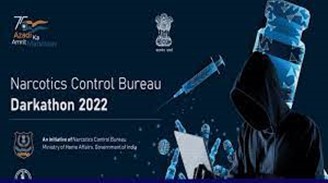
Source:
Image source:
Pandemic Treaty: WHO
- Context: The members of the World Health Organisation (WHO) have recently held the first round of negotiations towards the pandemic treaty.
- The pandemic treaty is expected to cover aspects like data sharing and genome sequencing of emerging viruses and equitable distribution of vaccines and drugs and related research throughout the world.
- The Treaty will be framed as per Article 19 of the WHO Constitution that gives the World Health Assembly the authority to adopt conventions or agreements on matters of health. A two-third majority is needed to adopt such conventions or agreements.
- The legal nature of the treaty is yet to be defined.
- While the EU wants the treaty to be legally binding, the U.S., Brazil and India have expressed reservations about the same.

Source:
Picture source:
India needs a mission on the Swachh Bharat lines to mend the learning gap: ET
Essence: During the shutdown of schools due to COVID, most states used a mix of Doordarshan and other local regional television networks to impart education to students. Several states, including Uttar Pradesh and Tamil Nadu, have recently started an ambitious volunteer-based initiative to combat learning losses. Both states' experiences have shown two key realities. One, online education in India is not yet capable of displacing traditional teaching methods. Two, putting any technology in front of a child and expecting him or her to ingest and learn without being distracted is expecting superhuman behaviour; hence, keeping children interested and learning involves some human touch.
Many other states have undertaken similar online and offline initiatives with varied outcomes. If the World Bank's prediction of a 10% increase in learning poverty as a result of the crisis is correct, India's learning poverty rate would have risen to 60% (54.8% in 2017) by now. Hence, India needs a national mission along the lines of Swachh Bharat to address the problem.
Why should you read this article?
- To have a better understanding of the concerns and challenges that come with online education in India.
- To learn what initiatives may be made to address the challenges more effectively.
View:
In war-torn Ukraine, has international law failed us once again?: HT
Essence: The editorial talks about the multiple measures available to punish Russia for its war-like actions in Ukraine. Ukraine could appeal at ICJ based on Convention on Prevention and Punishment of the Crime of Genocide (Genocide Convention) which both Russia and Ukraine have signed. Since Russia has alleged that Ukraine is committing genocide in their territory, which Ukraine objects, this “dispute” could possibly work towards haulting Russia’s assault on Ukraine. Second option available is the U4P resolution (United for Peace) to make recommendations to impose economic, diplomatic and travel sanctions to Russia. Other options include suspending Russia’s most favored nation status by countries under WTO’s GATT rules during times of war or emergency in international relations.
Targeting civilians and non-combatants, shelling in local/non-military areas must not be turned blind eye by international institutions and countries.
Why should you read this article?
- To understand the multiple ways in which Russia could be made to rethink on its war strategy on Ukraine.
- To know intricacies of international conventions to impose sanctions and their loopholes.
Source:
The growing scourge of anti-microbial resistance needs urgent attention: IE
Essence: The article highlights the concerns associated with Anti- microbial Resistance (AMR), which has become a major cause of concern especially during Covid-19 pandemic. The Global Action Plan and UN Resolution on AMR in 2016, which estimated 10 million deaths from AMR by 2050, have not produced satisfactory results. With multiple reports by eminent organisations and academicians pointing out that AMR in South Asia especially India is becoming the biggest cause of infection related deaths, there is an urgency to come up with a robust plan to tackle this menace.
Addressing AMR requires a multipronged and multisectoral approach. The urgency to develop new drugs should not discourage us from instituting measures to use the existing antimicrobials judiciously. Improved infection control in communities and hospitals, availability and utilisation of quality diagnostics and laboratories and educating people about antimicrobials have proved effective in reducing antimicrobial pressure — a precursor to resistance. The National Action Plan approved in 2017 has failed to achieve the desired results due lack of governance mechanism and adequate funding. The concerns around AMR to be addressed by comprehensive plan, driven by a designated coordinating agency backed with suitable funding.
Why you should read this article?
- The article talks about the concerns and urgency to address Anti-Microbial Resistance.
- The article points out the shortcomings in the current plan to curb AMR and suggest possible ways to effectively manage AMR.
Source:
Crematorium for Man’s best Friend
Background
- Dogs are known to be man’s best friend.
- The demand for a human disposal of the deceased dogs has led to the formalisation of constructing an electric crematorium of dogs in Ghaziabad.
About the initiative
- The residents of Ghaziabad have been demanding for a dog crematorium since a long time for better disposal of their pet dogs rather than throwing them in garbage dumps.
- The Municipal Corporation of the area has finalised the construction. This facility will help the city with the safe and scientific disposal of dead dogs.
- The service will be a charged one, every household needs to register their dogs with the authority and the cremation service will be 500 rupees per deceased dog.
- While the community dogs will be created free of cost as soon as it is brought under notice to the authority.

Quote: "The greatness of a nation and its moral progress can be judged by the way its animals are treated." -Mahatma Gandhi
Source:
Image source:
Share the article
Get Latest Updates on Offers, Event dates, and free Mentorship sessions.

Get in touch with our Expert Academic Counsellors 👋
FAQs
UPSC Daily Current Affairs focuses on learning current events on a daily basis. An aspirant needs to study regular and updated information about current events, news, and relevant topics that are important for UPSC aspirants. It covers national and international affairs, government policies, socio-economic issues, science and technology advancements, and more.
UPSC Daily Current Affairs provides aspirants with a concise and comprehensive overview of the latest happenings and developments across various fields. It helps aspirants stay updated with current affairs and provides them with valuable insights and analysis, which are essential for answering questions in the UPSC examinations. It enhances their knowledge, analytical skills, and ability to connect current affairs with the UPSC syllabus.
UPSC Daily Current Affairs covers a wide range of topics, including politics, economics, science and technology, environment, social issues, governance, international relations, and more. It offers news summaries, in-depth analyses, editorials, opinion pieces, and relevant study materials. It also provides practice questions and quizzes to help aspirants test their understanding of current affairs.
Edukemy's UPSC Daily Current Affairs can be accessed through:
- UPSC Daily Current Affairs can be accessed through Current Affairs tab at the top of the Main Page of Edukemy.
- Edukemy Mobile app: The Daily Current Affairs can also be access through Edukemy Mobile App.
- Social media: Follow Edukemy’s official social media accounts or pages that provide UPSC Daily Current Affairs updates, including Facebook, Twitter, or Telegram channels.




